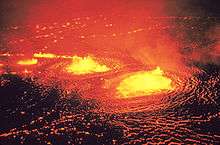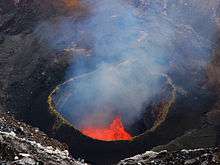Lava lake







Lava lakes are large volumes of molten lava, usually basaltic, contained in a volcanic vent, crater, or broad depression. The term is used to describe both lava lakes that are wholly or partly molten and those that are solidified (sometimes referred to as frozen lava lakes in this case).
Formation
Lava lakes can form in three ways:[1]
- from one or more vents in a crater that erupts enough lava to partially fill the crater; or
- when lava pours into a crater or broad depression and partially fills the crater; or
- atop a new vent that erupts lava continuously for a period of several weeks or more and slowly builds a crater progressively higher than the surrounding ground.
Behaviors
Lava lakes occur in a variety of volcanic systems, ranging from the basaltic Erta Ale lake in Ethiopia and the basaltic andesite volcano of Villarrica, Chile, to the unique phonolitic lava lake at Mt. Erebus, Antarctica. Lava lakes have been observed to exhibit a range of behaviours. A “constantly circulating, apparently steady-state” lava lake was observed during the 1969–1971 Mauna Ulu eruption of Kilauea, Hawaii.[2] By contrast, a lava lake at the 1983–1984 Pu'u 'O'o eruption of Kilauea displayed cyclic behaviour with a period of 5–20 minutes; gas “pierced the surface” of the lake, and the lava rapidly drained back down the conduit before the onset of a new phase of lake activity.[3] The behaviour observed is influenced by the combined effects of pressure within the reservoir, exsolution and decompression of gas bubbles within the conduit and, potentially, exsolution of bubbles within the magma reservoir. Superimposed upon this is the effect of bubbles rising through the liquid, and coalescence of bubbles within the conduit. The interactions of these effects can create either a steady-state recirculating lake, or a lake level that periodically rises and then falls.[4]
Notable examples
Persistent lava lakes are a rare phenomenon. Only a few volcanoes have hosted persistent or near-persistent lava lakes during recent decades:
- Erta Ale,[5] Ethiopia
- Ambrym, Vanuatu
- Mount Erebus,[6] Ross Island, Antarctica
- Kīlauea,[7] Big Island, Hawaii
- Mount Nyiragongo,[8] Democratic Republic of the Congo
Kīlauea uniquely has two persistent lava lakes: one in the Halemaʻumaʻu vent cavity within the summit caldera, and another within the Puʻu ʻŌʻō cone located on the east rift zone of the volcano.[9]
Nyiragongo lava lake has usually been the largest and most voluminous in recent history, reaching 700 meters wide in 1982,[10] although Masaya is believed to have hosted an even larger lava lake at the time of the Spanish conquest, being 1000 meters wide in 1670.[11]
In addition to the aforementioned persistent lava lakes, a certain number of occurrences of temporary lava lakes (sometimes called lava ponds or lava pools, depending on their size and nature[12]) have also been observed and are listed in the following table.
List of volcanoes having displayed past or present lava lake activity
- This list is incomplete; you can help by expanding it.
| Volcano | Location |
|---|---|
| Persistent or near-persistent lava lakes during recent decades | |
| Erta Ale[5] | Ethiopia |
| Mount Erebus[6] | Ross Island, Antarctica |
| Kīlauea[7] (two lava lakes in both Halemaʻumaʻu and Pu'u O'o craters) | Hawaii (Big Island) |
| Nyiragongo[8] (the largest one in the past century) | Democratic Republic of the Congo |
| Ambrym[13] (two lava lakes in both Benbow and Marum craters since around 1991)[14] | Ambrym Island, Vanuatu |
| Recent intermittent lava lake activity | |
| Masaya[15] | Nicaragua |
| Villarrica[16] | Chile |
| Karthala[17] | Grande Comore, Comoros |
| Piton de la Fournaise [18][19] (small temporary lava pond in Dolomieu crater) | Réunion Island |
| Ol Doinyo Lengai [20][21] (only active volcano in the world emitting carbonatite lava) | Tanzania |
| Unconfirmed lava lake activity | |
| Telica[22] (possibly in 1971 and 1999–2000) | Nicaragua |
| Tungurahua[23] (possibly in 1999) | Ecuador |
| Tofua[24] (possibly in 2004 and 2006) | Tofua Island, Tonga |
| Nabro[25] (possibly in 2012) | Eritrea |
| Lava lake activity suggested by satellite remote-sensing data | |
| Mount Michael[26] | Saunders Island, South Sandwich Islands |
| Mount Belinda[27] | Montagu Island, South Sandwich Islands |
| Mawson Peak[28] | Heard Island |
| Past lava lake activity (historical times) | |
| Mount Matavanu[29][30] (during the 1905–1911 eruption) | Savai'i Island, Samoa |
| Nyamuragira[30][31] (lava lake located within the summit caldera, confirmed for the first time in 1921, drained in 1938, and temporary lava pond in the Kituro cone on the SW flank, during the 1948 eruption) | Democratic Republic of the Congo |
| Capelinhos[32][33] (in 1958, a Surtseyan eruption) | Faial Island, Azores |
| Surtsey[34][35][36] (in 1964, during the 1963–67 eruption which led to the formation of the island) | Iceland |
| Tolbachik,[30][37] part of the Klyuchevskaya volcanic complex (last observation of lava lake activity in 1964) | Kamchatka, Russia |
| Etna[38] (in 1974) | Sicily, Italy |
| Mount Vesuvius (in 79 AD) | Naples, Italy |
| Ardoukôba[39] (in 1978) | Djibouti |
| Mount Mihara[40] (in 1986) | Izu Ōshima, Japan |
| Stromboli[41] (in 1986 and 1989) | Aeolian Islands, Italy |
| La Cumbre[42] (in 1995) | Fernandina Island, Galápagos |
| Pacaya[43] (in 2000 and 2001) | Guatemala |
| Lava lake activity on other planetary bodies | |
| Loki Patera[44] | Io |
See also
References
- ↑ "VHP Photo Glossary: Lava lake". Volcanoes.usgs.gov. Retrieved 2013-08-15.
- ↑ Swanson et al. (1979) Ground deformation at Pu'u 'O'o. U.S. Geological Survey Chronological narrative of the 1969-71 Mauna Ulu eruption of Kilauea volcano US Geological Survey Professional Paper 1056
- ↑ Wolfe et al. (1988). Geologic observations and chronology of eruptive events US Geological Survey Professional Paper 1463
- ↑ Witham and Llewellin (2006) Stability of Lava Lakes, Journal of Volcanology and Geothermal Research vol. 158 p.321-332
- 1 2 "Global Volcanism Program : Erta Ale". Volcano.si.edu. Retrieved 2013-08-15.
- 1 2 "Global Volcanism Program : Erebus". Volcano.si.edu. Retrieved 2013-08-15.
- 1 2 "Kīlauea". Global Volcanism Program. Smithsonian Institution.
- 1 2 "Nyiragongo". Global Volcanism Program. Smithsonian Institution.
- ↑ "HVO Kilauea Status". Volcanoes.usgs.gov. Retrieved 2013-08-15.
- ↑ "Global Volcanism Program : Nyiragongo". Volcano.si.edu. Retrieved 2013-08-15.
- ↑ "Pit crater structure and processes governing persistent activity at Masaya Volcano, Nicaragua" (PDF). Eps.mcgill.ca. Retrieved 2013-08-15.
- ↑ Tazieff, H. (1994). "Permanent lava lakes: Observed facts and induced mechanisms". Journal of Volcanology and Geothermal Research 63: 3–2. doi:10.1016/0377-0273(94)90015-9.
- ↑ "Ambrum". Global Volcanism Program. Smithsonian Institution.
- ↑ http://www.volcano.si.edu/volcano.cfm?vn=257040
- ↑ "Masaya". Global Volcanism Program. Smithsonian Institution.
- ↑ "Villarrica". Global Volcanism Program. Smithsonian Institution.
- ↑ "Global Volcanism Program : Karthala". Volcano.si.edu. Retrieved 2013-08-15.
- ↑ "Global Volcanism Program : Fournaise, Piton de la". Volcano.si.edu. doi:10.1029/2007GL031248. Retrieved 2013-08-15.
- ↑ "Terre et Volcans News v4". Terreetvolcans.free.fr. Retrieved 2013-08-15.
- ↑ "Global Volcanism Program : Lengai, Ol Doinyo". Volcano.si.edu. Retrieved 2013-08-15.
- ↑ "Etnatao: Ol Doinyo Lengai Volcano Tanzania". YouTube. 2010-02-11. Retrieved 2013-08-15.
- ↑ "Global Volcanism Program : Telica". Volcano.si.edu. Retrieved 2013-08-15.
- ↑ "Global Volcanism Program : Tungurahua". Volcano.si.edu. Retrieved 2013-08-15.
- ↑ "Global Volcanism Program : Tofua". Volcano.si.edu. Retrieved 2013-08-15.
- ↑ "Eruption volcanique, activité éruptive du volcan Nabro". Activolcans.info. Retrieved 2013-08-15.
- ↑ "Global Volcanism Program : Michael". Volcano.si.edu. Retrieved 2013-08-15.
- ↑ First recorded eruption of Mount Belinda volcano (Montagu Island), South Sandwich Islands, Bull Volcanol (2005) 67:415–422 (PDF)
- ↑ "Global Volcanism Program : Heard". Volcano.si.edu. Retrieved 2013-08-15.
- ↑ "Global Volcanism Program : Savai'i". Volcano.si.edu. 2013-01-03. Retrieved 2013-08-15.
- 1 2 3 Tazieff, Haroun, Cratères en feu, éd. Arthaud, 1951.
- ↑ "Global Volcanism Program : Nyamuragira". Volcano.si.edu. Retrieved 2013-08-15.
- ↑ "GC1QN4C Capelinhos Volcano [Faial] (Earthcache) in Arquipélago dos Açores, Portugal created by almeidara". Geocaching.com. Retrieved 2013-08-15.
- ↑ http://www.volcano.si.edu/volcano.cfm?vn=382010
- ↑ "Global Volcanism Program : Vestmannaeyjar". Volcano.si.edu. Retrieved 2013-08-15.
- ↑ "Inspired by Iceland stories: Tell us the story of your visit to Iceland". Stories.inspiredbyiceland.com. 2011-05-26. Retrieved 2013-08-15.
- ↑ Duncan C. Blanchard, From Raindrops to Volcanoes: Adventures With Sea Surface Meteorology, Dover Publications, 1967.
- ↑ "Global Volcanism Program : Tolbachik". Volcano.si.edu. Retrieved 2013-08-15.
- ↑ "Global Volcanism Program : Etna". Volcano.si.edu. doi:10.1029/2005GL022527.2005. Retrieved 2013-08-15.
- ↑ "Global Volcanism Program : Ardoukôba". Volcano.si.edu. 2013-01-03. Retrieved 2013-08-15.
- ↑ "Izu-Oshima Volcano Observatory". Retrieved 2014-02-20.
- ↑ "Global Volcanism Program : Stromboli". Volcano.si.edu. Retrieved 2013-08-15.
- ↑ "Global Volcanism Program : Fernandina". Volcano.si.edu. Retrieved 2013-08-15.
- ↑ "Global Volcanism Program : Pacaya". Volcano.si.edu. doi:10.1029/2007GC001791. Retrieved 2013-08-15.
- ↑ Howell, R. R.; R. M. C. Lopes (2007). "The nature of the volcanic activity at Loki: Insights from Galileo NIMS and PPR data". Icarus 186 (2): 448–461. Bibcode:2007Icar..186..448H. doi:10.1016/j.icarus.2006.09.022.
![]() This article incorporates public domain material from the United States Geological Survey document: the Volcano Hazards Program. "VHP Photo Glossary: Lava lake".
This article incorporates public domain material from the United States Geological Survey document: the Volcano Hazards Program. "VHP Photo Glossary: Lava lake".
External links
| Wikimedia Commons has media related to Lava lakes. |
- Lava lake in Nyiragongo Volcano crater. Video on France 24 TV
- Into the mouth of a volcano, video footage of lava lake in Vanuatu's Marum volcano